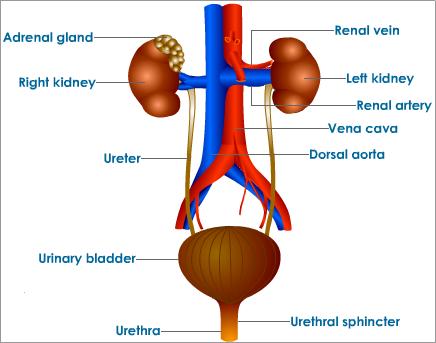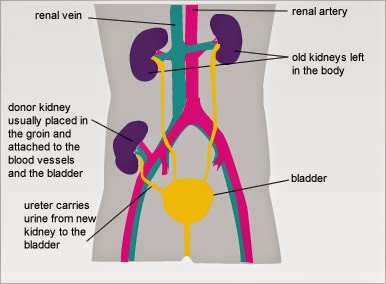Learning Outcomes.
- 1.1 Be able to demonstrate an understanding that cell metabolism leads to the build-up of waste products in the blood, including carbon dioxide and urea.
- Carbon dioxide is formed in the energy releasing process of respiration in all living cells.
- Urea is formed in the liver from the breakdown of excess amino acids and ends up in urine.
- 1.2 Know that urea is produced from the breakdown of excess amino acids in the liver and is removed by the kidneys
- Your kidneys remove urea from blood, adjust ion levels in blood, adjust water levels in blood by filtering out unwanted materials and absorbing useful materials.
- 1.3 Be able to describe the structure of the urinary system - excretion organs, including:
- a) renal artery and vein
- b) kidneys
- c) ureters
- e) urethra
- 1.4 Be able to describe possible treatments for kidney failure, including kidney dialysis and organ donation
- 1.5 Be able to describe the structure of a nephron, including:
- a) glomerulus and Bowman’s capsule
- b) convoluted tubules
- c) loop of Henlé
- d) collecting duct
- d) bladder
- 1.6 Be able to explain how the structure of the nephron is related to its function in filtering the blood and forming urine (osmoregulation), including:
- a) filtration in the glomerulus and Bowman’s capsule
- b) selective reabsorption of glucose
- c) reabsorption of water (osmoregulation)
- d) removal of excess water in urine
- 1.7 HT only: Be able to demonstrate an understanding of the role of ADH (produced by the pituitary gland) in regulating the water content of the blood
- 1.8 HT only: Be able to demonstrate an understanding of how ADH production is controlled by a negative feedback mechanism.
Why do we need to get rid of waste?
Our bodies carry out many complex reactions (metabolic reactions). Many of the products of these reactions are used by the cells in other reactions, but a few are not useful and need to be discarded. These are called Metabolic wastes.
Carbon dioxide is formed in the energy releasing process of respiration in all living cells. This takes place in the mitochondria in every cell.

The Carbon dioxide diffuses out of the cells and is then carried through the blood to the lungs, where it moves down it's concentration gradient into the alveoli and removed with ventilation.

Urea is formed in the liver from the breakdown of excess amino acids. and ends up in urine.

The urinary system is designed to remove waste products such as urea, as well as excess ions and water from our blood. The kidneys contain many nephrons which remove any waste, before reabsorbing any substances the body needs. Waste is stored in the bladder before being removed as urine. Our urinary system is responsible for producing, storing and removing urine from our bodies. Our urine contains urea and any excess water.
- 1.3 Be able to describe the structure of the urinary system - excretion organs, including:
- a) renal artery and vein
- b) kidneys
- c) ureters
- e) urethra

- 1.2 Know that urea is produced from the breakdown of excess amino acids in the liver and is removed by the kidneys
- 1.5 Be able to describe the structure of a nephron, including:
- a) glomerulus and Bowman’s capsule
- b) convoluted tubules
- c) loop of Henlé
- d) collecting duct
- d) bladder
Click here to see if you can remember all of the labels of the nephron.

Click here to play a quick fire 'name a nephron' game, how fast can you label?
- 1.6 Be able to explain how the structure of the nephron is related to its function in filtering the blood and forming urine (osmoregulation), including:
- a) filtration in the glomerulus and Bowman’s capsule
The blood flows into the kidney through a complex of capillaries called the glomerulus. The glomerulus is surrounded by a the first part of the nephron (a cup like structure) called the Bowmans capsule. The blood is flowing into the glomerulus at such high pressure, that any components of the blood that that can fit through the gaps in the capillary walls and in the holes in the Bowmans capsule, are squeezed out of the blood and caught by the Bowmans capsule. Water, ions and glucose and other small molecules pass into the tubule. Proteins and cells in the blood are too large, and stay in the blood.
- b) selective reabsorption of glucose
Obviously the body requires glucose for respiration. It is very important to get the glucose back into the bloodstream. This selective reabsorption occurs in the convoluted tubules of the nephron. The glucose is taken back into the capillaries and taken back in the bloodstream to the body.
- c) reabsorption of water (osmoregulation)
Osmoregulation is the bodies ability to retain water if water is short in the body, and the kidneys are able to remove more water from the blood if there is too much water in the blood.
- d) removal of excess water in urine.
Excess water is removed as urine. Urea is dissolved in this water and now it is called urine. When the body is holding onto water, the urea is more concentrated in the urine. When the body has excess water, the urea in the urine is less concentrated and can be quite dilute. The collecting duct is responsible for: the selective reabsorption of water and sending urine to the ureter.

Click here to work through an animation on how the nephron works.
1.7 HT only: Be able to demonstrate an understanding of the role of ADH (produced by the pituitary gland) in regulating the water content of the blood.
The water content of the blood is controlled by a hormone called ADH(anti-diuretic hormone). Different amounts of ADH are released into the bloodstream according to the concentration of the blood plasma.
| Plasma | Problem | ADH release | Effect of ADH | Effect on urine |
|---|---|---|---|---|
| High concentration | Too little water | Increases | More water reabsorbed by nephrons | More concentrated |
| Low concentration | Too much water | Decreases | Less water reabsorbed by nephrons | More dilute |
Click here for an animation showing the effect of ADH on the production of urine.
- 1.8 HT only: Be able to demonstrate an understanding of how ADH production is controlled by a negative feedback mechanism.
A negative feedback mechanism is one in which 'a change in a factor leads to the opposite change happening to keep things fairly constant, even if it keeps changing.
Too much water in the blood leads to water being removed from the blood.
Too little water in the blood leads to more water being left in the blood.
Therefore the ADH control of osmoregulation is an example of negative feedback.
1.4 Be able to describe possible treatments for kidney failure, including kidney dialysis and organ donation.
Symptoms of Kidney failure or chronic kidney disease. (you don't need to know this for your exam)
1.4 Be able to describe possible treatments for kidney failure, including kidney dialysis and organ donation.
Symptoms of Kidney failure or chronic kidney disease. (you don't need to know this for your exam)
Most people with CKD have no symptoms because the body can tolerate even a large reduction in kidney function.
In other words, we are born with a lot more kidney function than is necessary for survival. Kidney function is often sufficient if only one kidney is working. That is why people can give a kidney to someone needing a kidney transplant.
A change in kidney function is usually discovered through a routine blood or urine test. If you are diagnosed with kidney disease, your kidney function will be monitored with regular blood and urine tests, and treatment aims to keep any symptoms to a minimum.
If the kidneys continue to lose function and there is progression towards kidney failure (established renal failure or ERF), this will usually be tracked by blood tests and monitoring. If kidney failure does occur, the symptoms may include:
- weight loss and poor appetite
- swollen ankles, feet or hands (due to water retention)
- shortness of breath
- blood or protein in your urine (protein in your urine is not something you will notice as it can only be detected during a urine test)
- an increased need to urinate, particularly at night
- insomnia
- itchy skin
- muscle cramps
- high blood pressure (hypertension)
- nausea
- erectile dysfunction in men (an inability to get or maintain an erection).
Treatments for kidney failure
Kidney transplant.
A kidney is taken from a donor and surgically placed into the host (the patient with kidney failure).
All individuals have specific proteins on the surfaces of our cells. These HLA proteins are unique to that individual and are present on all organs. If an organ is taken from a donor, that organ will have HLA proteins on the surface that are identified as 'foreign' by the host. Antibodies from the host bind to the HLA proteins on the surface of the kidney.
The white blood cells in the host start destroying the kidney. This can be avoided by immunosuppression. This is a treatment in which the hosts white blood cells are dampened down so they stop attacking the organ, but also stop attacking pathogens. This is a huge risk to the patient so they need to be kept away from possible infections.
Dialysis
7. Dialysis is a process where a person with nonfunctioning kidneys can have their blood filtered by a machine. The image below outlines this process.










No comments:
Post a Comment